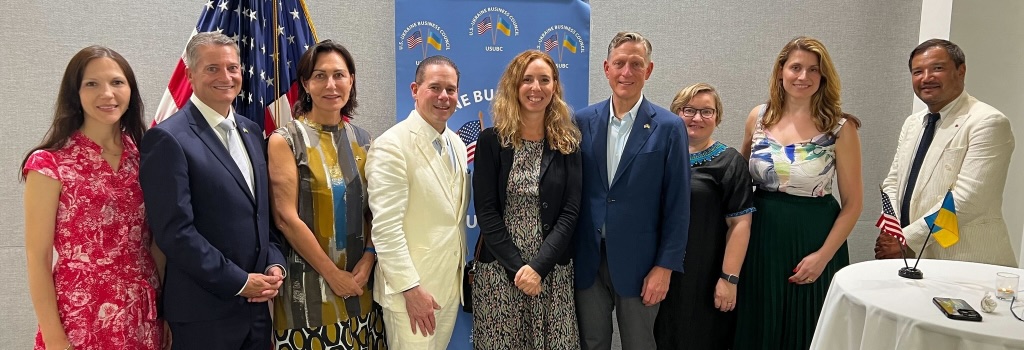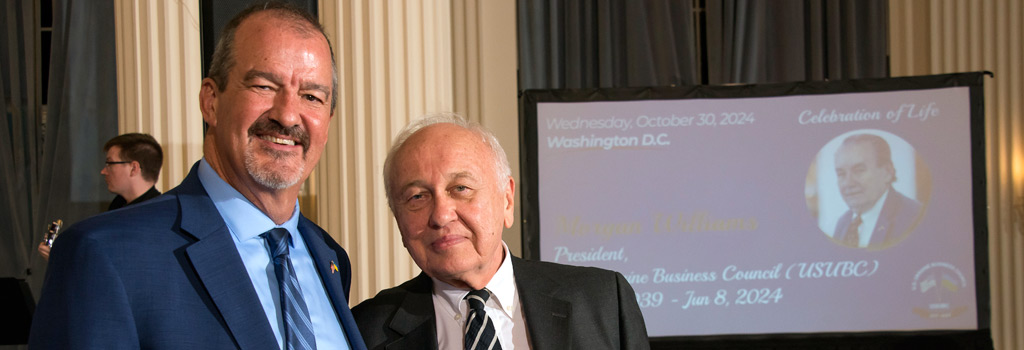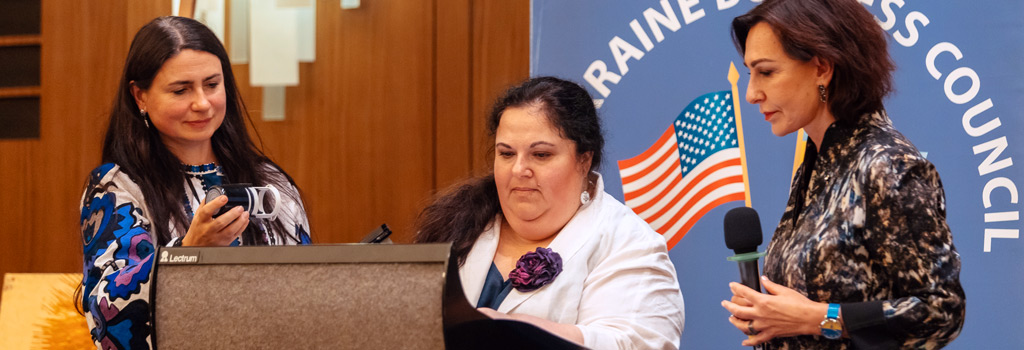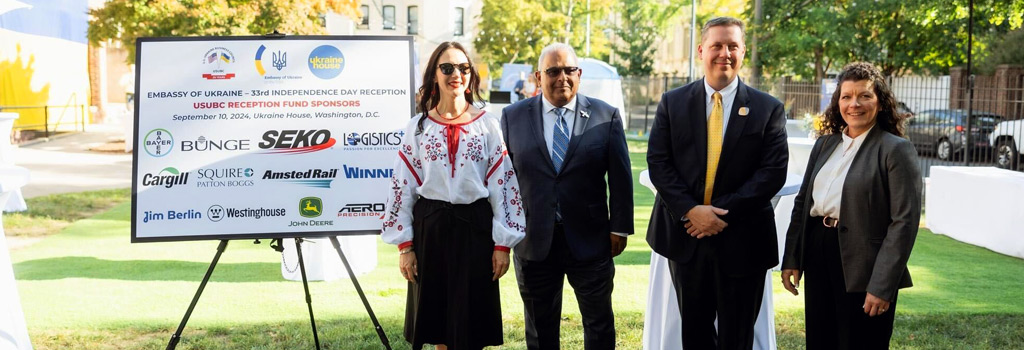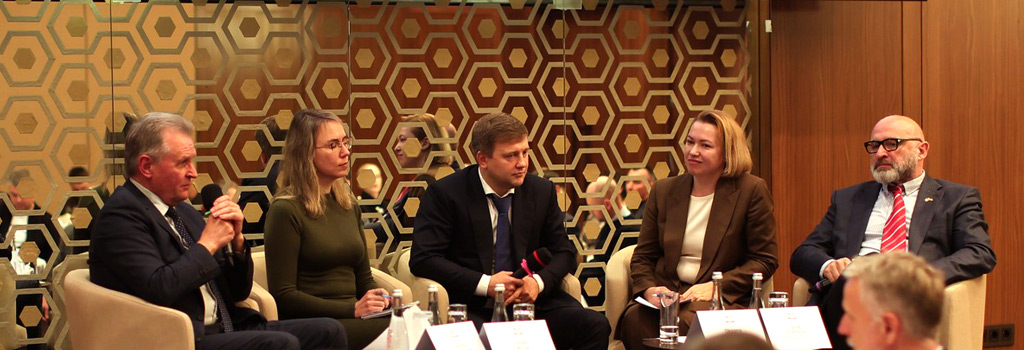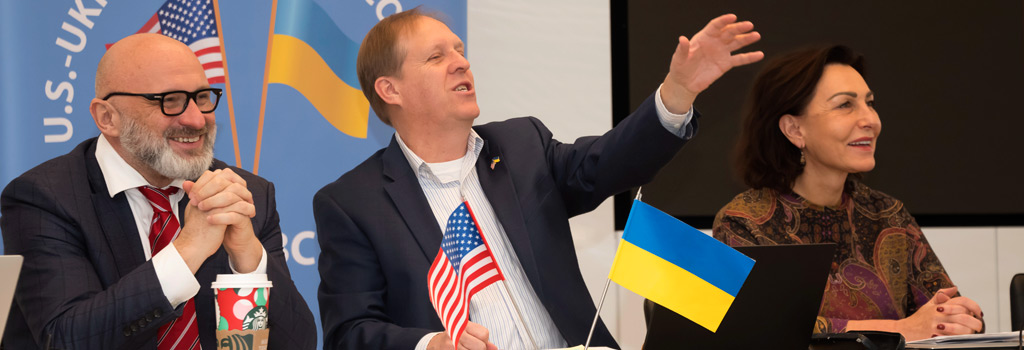Featured Galleries USUBC COLLECTION OF OVER 160 UKRAINE HISTORIC NEWS PHOTOGRAPHS 1918-1997
 Holodomor Posters
Holodomor Posters

PUTIN’S WAR – TEN YEAR ANNIVERSARY – 10 YEARS!
 Thu, Feb 22, 2024
Thu, Feb 22, 2024
The U.S.-Ukraine Business Council (USUBC) is a member of the Friends of Ukraine Network.
https://usukraine.org/about/friends-of-ukraine-network/national-security-task-force
 |
||||||||||||||||||||||||||||||||||||||||||||
 |
||||||||||||||||||||||||||||||||||||||||||||
|
Hello – Putin’s war against Ukraine is ten years old, ten years! Over and over we see articles, announcements of programs, and rallies to mark and discuss the “second anniversary” of the war. No, it is not the second anniversary - - it is the tenth anniversary of the war! I understand, and some qualify their description as the second anniversary of Putin’s full-scale invasion, and technically, that might be correct. But not talking in terms of the decade-long war misses the Ukrainian reality and inexcusably slides out of sight the embarrassing reality of Washington’s feckless ten-year response, which should be front and center. My point? Putin invaded Georgia in 2008, and our response was inadequate – no significant consequences. Putin got the message. 2014 Putin invaded Ukraine’s Crimean Peninsula, and our response was inadequate – no significant consequences. 2014 Putin conducted his phony, Kalashnikov-supervised referendum and annexed Crimea. Our response of denying the validity of the referendum was inadequate to the task. Putin got the message – Ukraine was essentially on its own. 2014, Putin invaded Ukraine’s Donbas, and our response was inadequate. More phony votes and Putin installs puppet governments in Luhansk and Donetsk – response inadequate to the task. In the Russian-occupied Ukrainian territories, Putin’s thugs were killing, raping, and torturing human beings. Putin started his government program of abduction of Ukrainian children, changing their birth certificates and names, putting them through indoctrination programs, and having them adopted as Russian children by Russian families. Armies fighting, civilians being tortured and killed, property being seized and destroyed, children being abducted, religious repression, cultural repression - this is war, and it has been going on for ten years. And during that time and through three American Administrations – Democrat and Republican – we have watched and mouthed support for Ukraine but never provided Ukraine what we knew – knew – it would need successfully to defend itself. Congress would appropriate money for support to Ukraine, but the then Administration would not use it to purchase weapons. Congress started appropriating funds for support to Ukraine, including specific language requiring at least a certain amount of the appropriated funds to be spent on “lethal weapons.” Then, the back-and-forth about defensive vs offensive weapons. Then the deplorable “we can’t give Ukraine” this weapon “because they won’t know how to use it.” Even though every time we eventually gave Ukraine such a weapon soon, the Ukrainians were not only using it but had found ways to use it effectively beyond how the manufacturer or our military thought it could be used. Remember why all this was happening? Because the war – the war that started in 2014 – was being fought, and we were, at best, providing too little too late. Weapons delayed are weapons denied. Human beings were dying because Ukraine did not have the weapons we knew they needed. Why is it Important to acknowledge Putin’s war has been going on for ten years? It is important to remember Putin has been killing Ukrainians, torturing Ukrainians – including children – and destroying hospitals, churches, schools, and residential buildings because for ten years, we – the United States – have not committed to a strategic goal in this war. We have not given Ukraine what we know they must have to defend their country successfully and defeat Putin. After ten (10) years it is passed time, we commit ourselves to a Ukrainian victory and adjust our policies and actions to conform with that policy and get Ukraine the weapons it has needed. With that, I present an article by The Wall Street Journal’s Ukraine Bureau Chief, James Marson, reflecting on the ten-year anniversary – note the headline “Bloody Decade.” |
||||||||||||||||||||||||||||||||||||||||||||
|
|
||||||||||||||||||||||||||||||||||||||||||||
|
THE WALL STREET JOURNAL Ukraine’s Bloody DecadeRussia has waged a long campaign to bring Kyiv back under its control. Despite a full-scale invasion, Ukraine is still resisting. |
||||||||||||||||||||||||||||||||||||||||||||
 |
||||||||||||||||||||||||||||||||||||||||||||
|
The print edition of this article has one picture – the online edition has many worthwhile pictures. I insert an on-point Michael Ramirez cartoon. |
||||||||||||||||||||||||||||||||||||||||||||
|
By James Marson Ukraine bureau chief for The Wall Street Journal Updated Feb. 20, 2024 12:03 am ET KYIV, Ukraine—It’s one decade since police gunned down dozens of civilians on a central street here, the first large-scale bloodshed of Russia’s efforts to keep Ukraine in its grasp. The protesters killed on Feb. 20, 2014, had been among hundreds of thousands who for months had been opposing the corrupt rule of then-President Viktor Yanukovych, a Russian protégé. He soon fled to Russia and a pro-Western government took over, prompting Russia to send troops to seize Crimea. In the years that followed, Russia used a variety of methods to try to take control of Ukraine, from a covert invasion of its neighbor’s east to years of political and economic pressure and chicanery. When they failed, Russian President Vladimir Putin launched a full-scale military invasion on Feb. 24, 2022. That didn’t work either. Ukraine repelled Russian forces from Kyiv and regained about half of the territory that Russia initially seized. However, Moscow still holds nearly 20% of Ukraine’s land. Here’s a look back at a decade of Ukrainian resistance against Russia—years marked by death and destruction, but also resilience and hope. 2014-15: The first Russian invasion It was late 2013 when tens of thousands of Ukrainians began rallying and camping out on Kyiv’s main square to protest government corruption and Yanukovych’s pivot to Russia. The protests were peaceful at first but turned violent when police tried to disperse them. On Feb. 20, two days after hours of deadly pitched battles between police and protesters had ended in a tense stalemate, the cops began pulling back and demonstrators followed them up Instytutska Street. As a new government sought to take charge in Kyiv, Russia was launching an invasion of Crimea, a peninsula in the Black Sea. The troops bore no insignia and were dubbed “little green men,” a crude effort by the Russians to mask their own involvement. Kyiv was in disarray and struggled to muster a response. The U.S., which had years earlier pressured Ukraine to give up nuclear weapons in return for “security assurances,” did next to nothing, and Putin swiftly annexed the peninsula. Next, he set his eyes on a bigger prize. After Russian agents tried and failed to whip up revolutions in cities across Ukraine’s east and south, a team of commandos led by a Russian former intelligence officer seized the eastern city of Slovyansk. Russia poured weapons and irregular fighters across the border. As Kyiv fought back, Russia sent in more sophisticated weapons, including a missile launcher that downed the MH17 passenger jet on July 17, 2014, killing all 298 aboard. After Ukrainian forces gained the upper hand, Moscow sent in its regular army, which dealt Kyiv’s troops a devastating blow in the city of Ilovaisk in September 2014. Ukraine agreed to a cease-fire but Russia continued its assaults, eventually taking the airport in the eastern capital of Donetsk after months of battles. In February 2015, Russian forces surrounded the city of Debaltseve, forcing Ukrainian President Petro Poroshenko to sign a new cease-fire deal known as the Minsk agreement that carved out two would-be statelets in eastern Ukraine that were run from Moscow. 2015-22: Ukraine turns away from Russia That cease-fire agreement largely halted fighting along the front lines, save for a few hot spots. As Russia sought to destabilize Ukraine from within, the country was shifting away from its former imperial master. Hundreds of Lenin statues were torn down. Ukrainians began switching from speaking Russian to Ukrainian. Ukrainians began turning away from the Russian Orthodox Church, for centuries the country’s dominant church. Individual parishes switched allegiance to a church run from Kyiv. Then, in January 2019, Ecumenical Patriarch Bartholomew I, the foremost leader in Orthodox Christianity, granted Ukraine its own independent church, despite Russian opposition. At the same time, Ukrainians were tired of the war and the corruption that hampered the economy and state institutions. In a presidential election, a television comedian called Volodymyr Zelensky won by a landslide in the first round. He promised to bring an end to the war and root out corruption. When he took office, that proved harder than he had thought. Putin showed no interest in a deal unless it gave him greater control over Ukraine. So Zelensky began pursuing closer ties with the West. He sought to advance Ukraine’s efforts to join the North Atlantic Treaty Organization and the European Union. Those efforts were going nowhere fast, but Putin was making increasingly agitated statements about Ukraine and stating Russian historical claims to Ukrainian territory and the right to rule there. By fall 2021, he was gathering tens of thousands of troops around Ukraine. The U.S. warned he was planning to invade. Zelensky, fearing social and economic upheaval, urged calm. 2022-present: Russia launches biggest land war in Europe since World War II In the early hours of Feb. 24, Russia launched airstrikes and armored columns against Ukraine. Tanks poured over the border from the north, south and east. The most important initial thrust was on Kyiv, where civilians came to the aid of the army and thwarted the assault. The Russians were halted and, by the end of March, repelled from the capital. When the Russians withdrew, they left hundreds of civilians dead in towns and villages around Kyiv, including Bucha. That hardened Ukrainian determination and support from the West, which began providing dozens of heavier weapons, such as artillery systems. Russia regrouped and began advancing in the northeast, but by fall its troops were exhausted, and a lightning thrust by Kyiv’s forces took back hundreds of square miles of territory around Ukraine’s second city of Kharkiv. In the south, Ukraine retook the city of Kherson, a regional capital. By the end of the year, Ukraine had regained half the territory it had lost to Russia since the start of the war. Zelensky received a hero’s welcome on a visit to Washington. But Russia had firmed up its defensive lines with thousands of convicts recruited by the Wagner paramilitary group. Wagner led assaults on the eastern city of Bakhmut, the bloodiest battle of the war, that ended in a Russian victory in May 2023. The following month, Ukraine launched a counteroffensive led by thousands of troops trained and equipped with tanks from the West. [But Ukraine was not provided the weapons the United States would require its own military to have before allowing an offensive to go forward. RAM] It quickly went wrong, as the Russians had built stiff defenses, including minefields and trench systems. By fall, Ukraine had managed to take only one village in the main direction of its assaults, and the operation petered out. As the full-scale war approached its third year, it became a bloody stalemate. Ukraine, its manpower and equipment depleted, is on the defensive. Russia is inching forward but has been unable to achieve a large breakthrough. For Ukraine, much now depends on whether Western allies can muster more military support. Write to James Marson at james.marson@wsj.com |
||||||||||||||||||||||||||||||||||||||||||||
|
|
||||||||||||||||||||||||||||||||||||||||||||
|
||||||||||||||||||||||||||||||||||||||||||||
 |
||||||||||||||||||||||||||||||||||||||||||||
LINK: View this email in your browser
